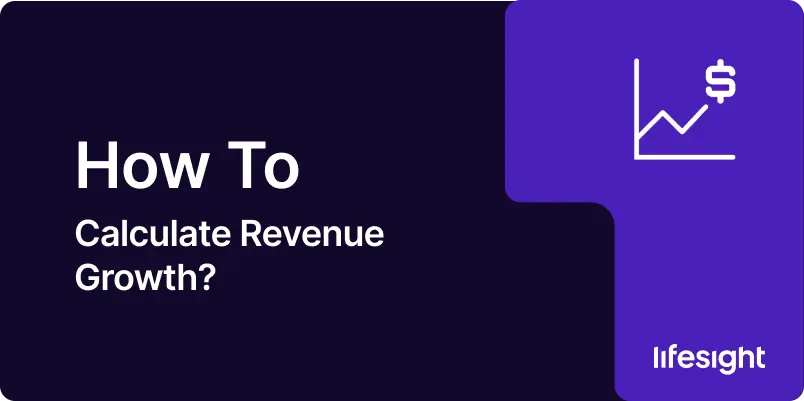
In the dynamic world of business and marketing, few metrics are as universally important as revenue growth. Whether you’re a startup founder looking to attract investors, a marketing manager justifying your budget, or a business analyst tracking company performance, understanding how to calculate and interpret revenue growth is crucial. This guide will walk you through everything you need to know about revenue growth, from basic calculations to advanced strategies for leveraging this metric in your business and marketing decisions.
What is Revenue Growth?
Before we dive into the calculations, let’s define what we mean by revenue growth:
Revenue growth is the increase (or decrease) in a company’s sales over a specific period, usually expressed as a percentage. It’s a key indicator of a company’s financial health and market performance.
For business professionals and marketers, understanding revenue growth is essential because:
- It’s a primary measure of business performance and success
- It helps in setting realistic business targets and forecasting
- It’s crucial for attracting investors and securing funding
- It guides strategic decisions about expansion, product development, and marketing spend
- It’s often used as a benchmark for comparing performance against competitors and industry standards
The Basic Formula for Calculating Revenue Growth
The basic formula for calculating revenue growth is straightforward:
Revenue Growth Rate = ((Current Period Revenue – Prior Period Revenue) / Prior Period Revenue) x 100
This formula gives you the percentage increase (or decrease) in revenue between two periods.
Step-by-Step Guide to Calculating Revenue Growth
Let’s break down the process of calculating revenue growth with a practical example:
Step 1: Determine Your Time Periods
First, decide on the periods you want to compare. Common comparisons include:
- Year-over-Year (YoY)
- Quarter-over-Quarter (QoQ)
- Month-over-Month (MoM)
For this example, let’s use annual data.
Step 2: Gather Your Revenue Data
You’ll need the total revenue figures for both periods:
- Current period revenue
- Prior period revenue
Let’s say you’re analyzing the performance of a software company:
- 2023 Revenue (Current Period): $10,000,000
- 2022 Revenue (Prior Period): $8,000,000
Step 3: Apply the Revenue Growth Formula
Now, let’s plug these numbers into our formula:
Revenue Growth Rate = (($10,000,000 – $8,000,000) / $8,000,000) x 100 = ($2,000,000 / $8,000,000) x 100 = 0.25 x 100 = 25%
This means your company experienced a 25% revenue growth from 2022 to 2023.
Interpreting Revenue Growth
Now that we’ve calculated revenue growth, what does this percentage mean for your business or marketing strategy?
- Positive Growth: Any percentage above 0% indicates your revenue is increasing. The higher the percentage, the faster your growth.
- Negative Growth: A percentage below 0% means your revenue is decreasing, which could signal challenges that need addressing.
- Industry Comparison: Compare your growth rate to industry averages to gauge your relative performance.
- Historical Trends: Look at your growth rate over several periods to identify trends or cyclical patterns.
- Goal Setting: Use historical growth rates to set realistic targets for future periods.
Real-World Applications in Business and Marketing
Let’s explore some specific scenarios where calculating and analyzing revenue growth can inform your business and marketing decisions:
1. Evaluating Marketing Campaign Effectiveness
Scenario: You’ve launched a major marketing campaign and want to assess its impact on revenue.
Pre-Campaign Quarter Revenue: $1,000,000 Post-Campaign Quarter Revenue: $1,200,000
Revenue Growth = (($1,200,000 – $1,000,000) / $1,000,000) x 100 = 20%
The 20% revenue growth suggests that the marketing campaign had a positive impact. However, you’d need to consider other factors like seasonal trends and overall market conditions to make a definitive conclusion.
2. Product Line Performance Analysis
Scenario: You want to compare the growth rates of different product lines to inform resource allocation.
Product A:
- Last Year Revenue: $500,000
- This Year Revenue: $600,000
- Growth Rate = (($600,000 – $500,000) / $500,000) x 100 = 20%
Product B:
- Last Year Revenue: $300,000
- This Year Revenue: $420,000
- Growth Rate = (($420,000 – $300,000) / $300,000) x 100 = 40%
Product B shows a higher growth rate, which might suggest allocating more resources to its production or marketing. However, also consider factors like profit margins and market potential.
3. Market Expansion Decision
Scenario: You’re considering expanding into a new market and want to project potential revenue growth.
Current Market:
- Current Year Revenue: $5,000,000
- Projected Next Year Revenue: $5,750,000
- Projected Growth Rate = (($5,750,000 – $5,000,000) / $5,000,000) x 100 = 15%
New Market Projection:
- First Year Revenue Estimate: $1,000,000
- Second Year Revenue Estimate: $1,500,000
- Projected Growth Rate = (($1,500,000 – $1,000,000) / $1,000,000) x 100 = 50%
The higher projected growth rate in the new market might make it an attractive expansion opportunity, but be sure to consider risks and initial investment costs as well.
Advanced Considerations in Revenue Growth Calculations
As you become more proficient with basic revenue growth calculations, consider these advanced concepts:
1. Compound Annual Growth Rate (CAGR)
When looking at growth over multiple years, CAGR provides a smoothed rate of growth over the period:
CAGR = (Ending Value / Beginning Value)^(1/n) – 1
Where n is the number of years.
2. Organic vs. Inorganic Growth
Distinguish between growth from existing operations (organic) and growth from acquisitions or mergers (inorganic):
Organic Growth Rate = ((Current Organic Revenue – Prior Organic Revenue) / Prior Organic Revenue) x 100
3. Real Growth vs. Nominal Growth
Adjust for inflation to get a more accurate picture of real growth:
Real Growth Rate = ((1 + Nominal Growth Rate) / (1 + Inflation Rate)) – 1
4. Segmented Growth Analysis
Calculate growth rates for different segments of your business:
- By product or service line
- By geographic region
- By customer demographic
This granular approach can reveal hidden trends and opportunities.
Common Pitfalls to Avoid
When working with revenue growth calculations, watch out for these common mistakes:
- Ignoring Context: High growth rates might look impressive but could be misleading if coming from a small base.
- Overlooking Seasonality: Comparing a peak season to an off-season can give a distorted view of growth.
- Neglecting External Factors: Economic conditions, competitive actions, or regulatory changes can impact revenue growth.
- Focusing Only on Percentage: Remember to consider absolute dollar amounts alongside percentages.
- Short-Term Thinking: Don’t let short-term growth drive decisions that could harm long-term sustainability.
Tools for Revenue Growth Analysis
Several tools can assist you in calculating and analyzing revenue growth:
- Spreadsheet Software: Excel or Google Sheets are excellent for basic calculations and creating visual representations of your data.
- Financial Analysis Software: Tools like QuickBooks or Xero can provide revenue data and basic growth calculations.
- Business Intelligence Platforms: Tableau, Power BI, or Looker can help you create dynamic dashboards to track revenue growth across different dimensions.
- CRM Systems: Platforms like Salesforce or HubSpot often have built-in reporting features for revenue metrics.
- Custom Analytics Solutions: Many companies develop proprietary tools to track and analyze revenue growth across various business segments.
Leveraging Revenue Growth in Your Business and Marketing Strategy
Understanding and effectively using revenue growth calculations can significantly enhance your decision-making processes. Here’s how you can leverage this metric:
- Goal Setting: Use historical revenue growth data to set realistic and ambitious targets for your business.
- Resource Allocation: Invest more in product lines, markets, or marketing channels that show higher growth rates.
- Performance Evaluation: Use revenue growth as a key metric in evaluating the success of business initiatives or marketing campaigns.
- Forecasting: Utilize revenue growth trends to forecast future performance and plan accordingly.
- Competitive Analysis: Compare your revenue growth to industry benchmarks to identify areas for improvement or competitive advantages.
- Investor Relations: Use revenue growth data to tell a compelling story about your business’s performance and potential.
- Marketing Budget Justification: Demonstrate the impact of marketing efforts on revenue growth to justify budget allocations.
Conclusion
Revenue growth is more than just a number, it’s a story of your company’s success and a roadmap for future expansion. By mastering the calculation and interpretation of revenue growth, you arm yourself with a powerful tool to drive yaour business and marketing strategies.
Remember, while revenue growth is a critical metric, it should be used in conjunction with other KPIs like profit margins, customer acquisition costs, and customer lifetime value. The most successful strategies take a holistic view, balancing short-term growth with long-term sustainability and profitability.
As you continue to refine your approach to calculating and applying revenue growth insights, you’ll develop a more nuanced understanding of your business’s performance and potential. This knowledge will empower you to make more informed decisions, allocate resources more effectively, and ultimately drive sustainable growth for your company.
So, the next time you’re planning a marketing campaign, considering a new product launch, or making a case for increased budget, remember to leverage your revenue growth data. It might just be the key to unlocking your next big business breakthrough!
Free essential resources for success
Discover more from Lifesight















